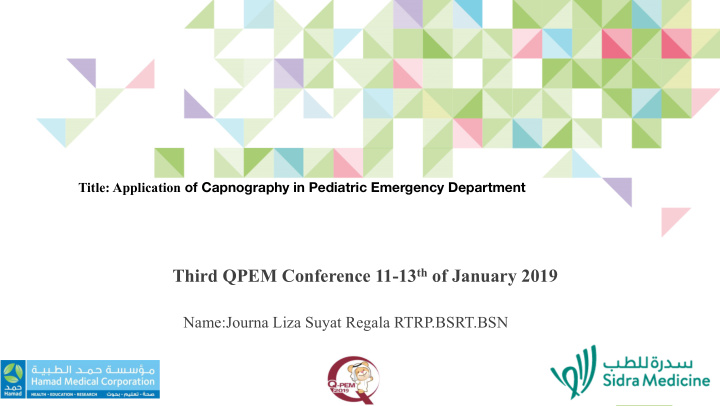



Title: Application of Capnography in Pediatric Emergency Department Third QPEM Conference 11-13 th of January 2019 Name:Journa Liza Suyat Regala RTRP.BSRT.BSN
DISCLOSURE I do not have any relevant financial relationship with commercial interest to disclose.
Learning Objectives At the end of the presentation, the attendee will be able to: Understand importance of monitoring end-tidal carbon dioxide and the 1 valuable information it provide for patient assessment and treatment. Identify the cause of High and Low ETtCO2 2 values. Understand importance of capnography in monitoring respiratory 3 status of spontaneous beating patient .
Capnography (End-Tidal Capnography) Refers to the graphical measurement of the partial pressure of carbon dioxide (EtCO2,PetCO2).First establish in the 1930s,clinical use of EtCO2 measurement become accessible in the 1950s. More generally end-tidal capnography is used in the following settings: • General anesthesia • Procedural sedation, including sedation with monitored anesthesia care • Analysis of ventilation in mechanical ventilated patient. • Cardiac arrest ,to confirm tracheal intubation and adequacy of chest compression. • Ensure ventilation as to confirm a spontaneously ventilating patient.
The use of Capnography in Spontaneous Breathing Patient In July 2013, the journal of Emergency medicine published article titled(Capnography for the non-intubated patient in the Emergency setting) Capnography can be an effective tool for measuring RR and adequacy of ventilation Ex: narcotic, analgesis, benzodiazepines and seizure management. Hypercabnia can exist in the presence of normal oxygenation. Capnography gave advanced warning for low oxygenation condition. Capnography was 100% sensitive for predicting hypoxia. Using of capnography is cost efficiencies in the ER environment. EX: DKA (fewer blood draws) PE( reducing unnecessary CT scans)
Indication of Capnography in Spontaneous breathing patient Respiratory distress is one of the most common patient complain. • Waveform capnography is a valuable tool to determine the cause and severity of respiratory distress. • Monitor the patients response to treatment. • Capnography also detects shocks. Pathology and the Capnography Cause of High EtCO2 Cause of Low EtCO2 Malignant hyperthermia Hypothermia Shivering Low cardiac output Fever Pulmonary Embolism Sepsis Hyperventilation Endocrine disease Hypoventilation
Normal Capnogram and Phase Normal Capnogram - Phase I Normal Capnogram - Phase II Normal Capnogram - Phase III Normal Capnogram - Phase IV
Normal Value of PaCO2 vs PETCO2 PaCO 2 Normal Values : • • 35- 45 mmHg ETCO 2 Normal Values: • 30- 43 mmHg 4.0-5.7 kPa 4.0-5.6% Note :Arterial - End Tidal CO 2 Gradient • In healthy lungs the normal a- ET co2 gradient is 2-5 mmHg The gradient will increase due to ventilation/perfusion mismatch, decreased cardiac function and decreased pulmonary blood flow
Normal and Abnormal waveform Air way obstruction Absent ETCO2 level and waveform Normal Reduced ETCO2 level Decreasing ETCO2 level towards Increased ETCO2 level from Sudden significant increase Curare cleft normal normal in ETCO2 Increased ETCO2 values toward normal
Take home messages The shape of the capnography waveform helps determine the cause of the problem. Think respiratory failure when ETCO2 is high Think perfusion, metabolic or psychological problem when ETCO2 is low Capnography provides real-time feedback on response to treatment. Hyperventilation with a BVM is harmful and capnography can help prevent it.
Recommend
More recommend